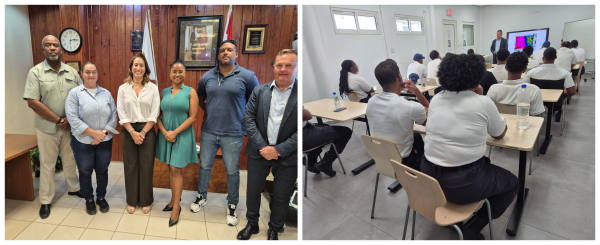 PHILIPSBURG:--- From 3 to 14 November, Sint Maarten hosted the third and final module of the Geographic Profiling training. With this final component completed, Sint Maarten has become the first jurisdiction within the Caribbean part of the Kingdom of the Netherlands to complete the full training programme. The course was led by Bert Adriaens of Space Geographic Profiling Support, one of the most experienced geographic profilers in the Kingdom. Minister of Justice Nathalie Tackling personally presented the certificates and expressed her appreciation for the participants’ commitment and the professional organization of the training.
PHILIPSBURG:--- From 3 to 14 November, Sint Maarten hosted the third and final module of the Geographic Profiling training. With this final component completed, Sint Maarten has become the first jurisdiction within the Caribbean part of the Kingdom of the Netherlands to complete the full training programme. The course was led by Bert Adriaens of Space Geographic Profiling Support, one of the most experienced geographic profilers in the Kingdom. Minister of Justice Nathalie Tackling personally presented the certificates and expressed her appreciation for the participants’ commitment and the professional organization of the training.
Geographic Profiling is an analytical method that uses patterns in time and space to determine a likely area of offender activity. The method is based on the premise that offenders rarely move entirely at random; they select routes and locations based on routine patterns, knowledge of the area, and a desire to avoid risk. By systematically analyzing incident locations, investigators can narrow down search areas, identify links between cases, and focus investigative resources more effectively. This makes the method particularly valuable for island environments with limited surface area, complex road networks, and cross-border mobility. It enables law enforcement to interpret offender behavior more quickly and deploy personnel and resources more efficiently.
During the module, participants worked on a cold case investigation and analyzed a series of recent robberies on the island. The practical, hands-on approach enabled immediate application of the methodology to a local context, resulting in concrete patterns and hypotheses that can further support investigations.
The training also included an interactive workshop for 18 police trainees. The students showed strong interest in the method, asking insightful questions from the start about how to integrate geographic insights into their daily police work. The trainer emphasized that these first responders play a vital role in gathering crucial information about escape routes, access points, and other spatial patterns that can be of significant value in later analysis.
Trainer Bert Adriaens, who has taught in many countries, highlighted how enriching it is to encounter new perspectives with each training. He reflected: “Wherever you are in the world, and whatever island you’re on, you’re always learning from others. My hope is to offer participants tools and experiences they can truly make their own.” He noted that he was once again impressed by how much can be achieved with limited resources. The dedication, involvement, and ingenuity of the participants left a strong impression on him.
With the completion of this training, Sint Maarten now has access to an internationally recognized method used in solving complex crimes. For law enforcement, this means a more accurate understanding of offender behavior, greater investigative focus, and improved ability to link cases. It provides the police with a powerful tool to act faster and more effectively against crime.












